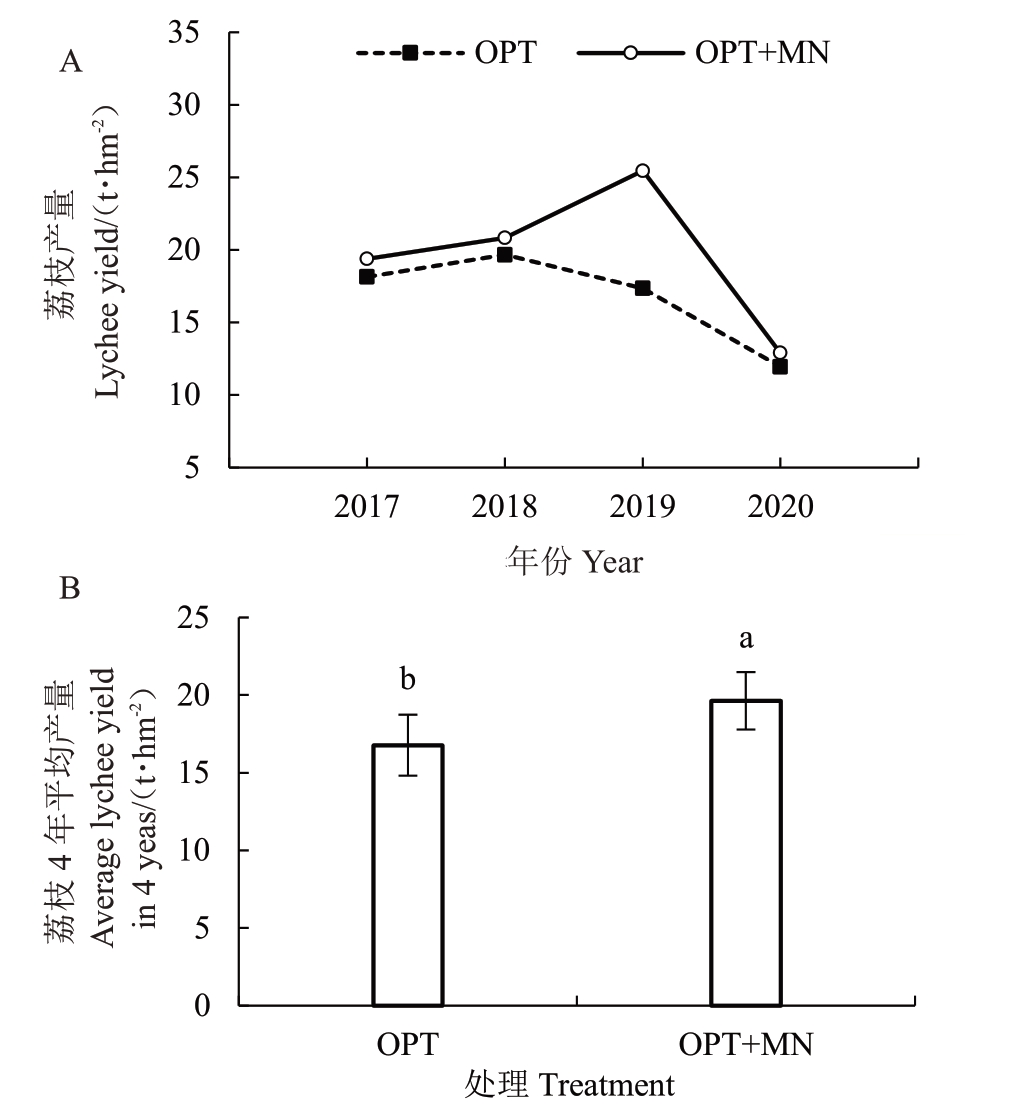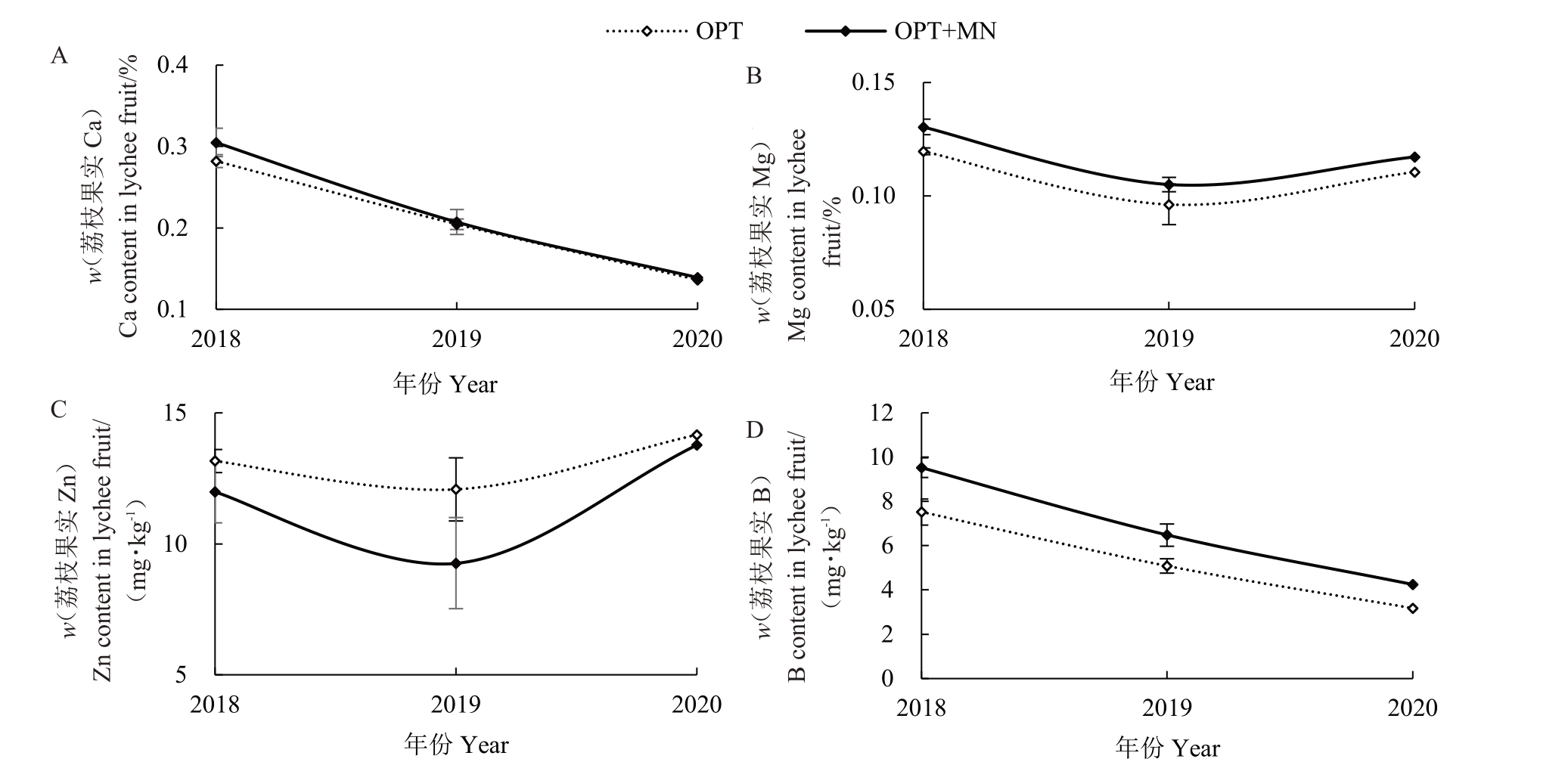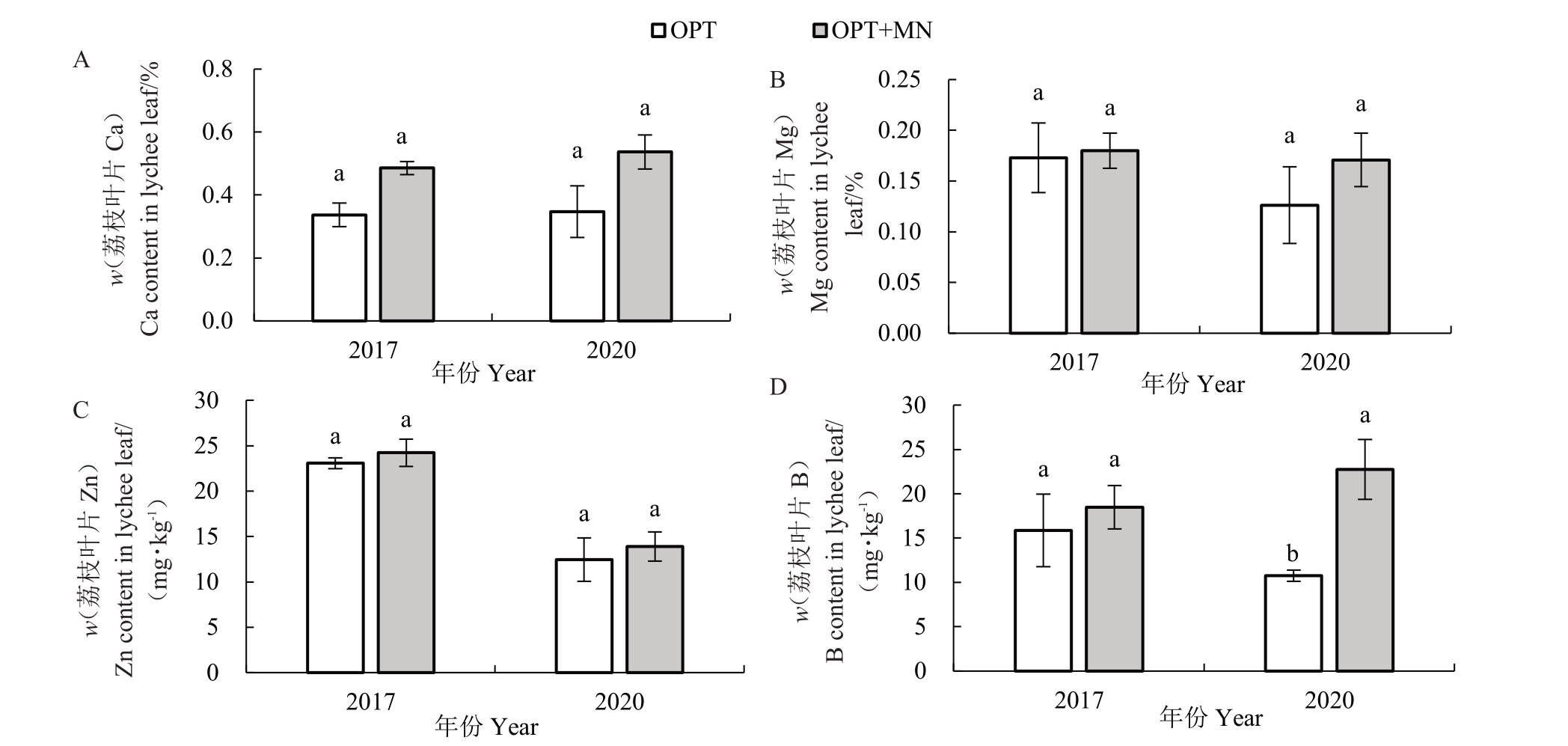荔枝(Litchi chinensis Sonn.)是我国南方热带亚热带常绿果树,也是华南地区最主要水果之一,种植面积54.7 万hm2,主要分布在广东、广西、海南、福建、台湾、四川、重庆、云南等地。据统计,2017年广东荔枝种植面积为24.54 万hm2,年产量117.47 万t,分别占全国荔枝种植面积和产量的44.9%和51.1%[1]。然而,在实际生产过程中,荔枝单产低且不稳定,存在坐果率低、大小年现象以及荔枝养分供应不平衡引起的裂果和低产等问题[2]。影响荔枝产量有诸多因素,基本营养元素的平衡供应是提高作物产量的最重要因素之一。通常在外界气候因素正常年份,化肥(尤其是氮肥)的施用被认为是荔枝稳定成花、产量和品质的重要保障[3-4]。然而,除氮磷钾营养元素外,中微量营养元素在保障荔枝生命周期内树体正常生长发育发挥着举足轻重的作用,这些元素不仅能保持树体营养平衡,而且还有利于提高果实产量与品质,并对果树抗逆能力也非常有帮助[5-6]。
前期对广东省荔枝主产区80 多个具有代表性荔枝园调研和采样测试分析,发现大部分荔枝园土壤肥力水平整体偏低且养分分布不均衡;不同果园土壤营养状况差异较大,镁是荔枝园土壤最缺乏的元素,硼钙次之。荔枝园土壤养分基本状况在不同种植区域内存在很大的相似性,笔者的调研结果与前人研究报道基本一致[7-8]。荔枝园土壤营养不平衡与果农养分管理习惯密切相关(如重施化肥而轻施有机肥、重施氮磷钾而忽略中微量营养的补充),这些不合理的施肥习惯不仅导致荔枝产量低下,而且由营养失衡导致裂果、果皮褐变、畸形等生理病害,引起果实品质降低,严重影响荔枝产业的绿色可持续发展[9]。相对于其他粮食作物与经济作物而言,施肥对荔枝产量及其在树体各器官的累积分布相关研究十分有限,且多是针对大量营养氮磷钾的研究[10]。因此,本研究的主要目的是探讨在氮磷钾营养供应相对合理的范围内,连续多年补充适量中微肥对维持树体各部位营养平衡和荔枝产量及品质的影响,以期为荔枝生产中中微肥施用提供科学依据。
1 材料和方法
1.1 试验地点
本试验自2016 年至2020 年在广东省湛江市廉江良垌镇赤岭村(110.23 E°,21.29 N°)农户荔枝园内开展。试验前采集0~50 cm 土层土壤并进行基本理化性质测定:土壤pH值为4.68,有机质含量(w,后同)17.6g·kg-1,碱解氮79mg·kg-1,有效磷50.8mg·kg-1,速效钾86.5 mg·kg-1,交换性钙360.4 mg·kg-1,交换性镁48.0mg·kg-1,有效锌0.7mg·kg-1,有效硼0.23mg·kg-1,有效硫31.4 mg·kg-1,有效铁94.0 mg·kg-1,有效锰2.0 mg·kg-1。供试荔枝园属于中国南方典型酸性坡地土壤,总体表现为土壤呈强酸性,肥力水平偏低,除磷、硫和铁营养含量相对丰富外,土壤有机质、碱解氮、速效钾、有效钙、有效锰及有效锌含量处于中等偏下水平,且土壤中有效镁、有效硼含量严重缺乏(参照全国第二次土壤普查养分分级标准)。
1.2 试验设计
供试品种为国内主栽品种妃子笑,砧木为黑叶,树龄8 a(年),每666.7 m2种植37 株。选择树势相对一致的荔枝树作为试验用树。试验设2 个处理,分别为常规氮磷钾化肥优化用量处理(OPT)和氮磷钾配施中微肥处理(OPT+ MN),中微肥主要包括镁、锌、硼3 种营养元素。单株重复,每个处理3 次重复。2016—2020 年连续4 a 开展研究试验,试验结束进行破坏性取样(将荔枝整棵树从根到地上部分部位进行采样分析)。供试肥料为尿素(含N 46.0%)、过磷酸钙(含P2O5 12.0%)、氯化钾(含K2O 60.0%)、七水硫酸镁(含Mg 9.8%)、七水硫酸锌(含Zn 23.0%)、硼砂(含B 11.3%)。两处理氮、磷、钾用量保持一致,2016 年和2017 年的年周期化肥用量相同,每株分别为0.6 kg N,0.18 kg P2O5和0.6 kg K2O;2018 年和2019 年的年周期化肥用量相同,每株分别为0.46 kg N,0.07 kg P2O5 和0.37 kg K2O。中微肥用量每株分别为80 g 硫酸镁,20 g 七水硫酸锌,40 g 硼砂,且每年采果后在每株树冠两侧滴水线下开沟施入8 kg 有机肥(总养分含量≥4%,N∶P2O5∶K2O=1.5∶1.0∶1.5,质量比)。氮、磷肥分别于采收后(7 月下旬)、开花前(1 月下旬)、谢花期(4 月中下旬)和壮果期(5 月上中旬)按30%、20%、20%和30%的比例施入;钾、镁肥分别按20%、20%、20%和40%的比例于以上4 个节点施入;锌、硼肥分别于采后和花前对半施入。采后肥采取开沟施肥模式,其他时期主要以撒施为主。试验过程中,各处理水分管理、病虫害防控等措施均保持一致。
1.3 测定项目与方法
果实成熟期,单株分次全部采收计产并进行采样。采果后在荔枝树冠4个对角方向选取结果母枝第2 或第3 复叶的第2 对小叶1 枚,每处理采集50 ~60 枚叶片。2020 年采果后,两处理各选取3 株荔枝树进行破坏性取样,分别获得植株根系、枝干和叶片各部位鲜质量、干质量、营养含量等指标数据。所有植株样品洗净后105 ℃杀青,75 ℃下烘干后粉碎备用。植株样品经过H2SO4-H2O2消煮后,然后分别采用蒸馏法、钼锑抗比色法和火焰光度法测定氮、磷、钾含量;钙、镁、锌含量先采用HNO3-HClO4消煮,再用原子吸收风光光度法测定;硼含量采用姜黄素比色法测定[11]。
1.4 数据处理
采用Microsoft Excel 2010 进行数据整理和图表制作,采用SAS 9.0软件对荔枝产量、叶片和果实中中微量营养积累量等参数进行方差分析,采用Duncan’s 新复极差法进行多重比较。
2 结果与分析
2.1 荔枝农艺性状
由表1 可知,不同施肥处理对荔枝树冠直径和各部位生物量(鲜质量)农艺性状的影响不同。OPT+MN处理较OPT处理树冠直径和根质量的影响差异不明显,但前者增加了叶片与枝干生物量,增幅分别达26.7%和17.0%。
表1 不同施肥措施对荔枝农艺性状的影响
Table 1 Effects of different fertilization measures on agronomic characters of lychee

注:OPT.氮磷钾优化施肥处理;OPT+MN.氮磷钾配施中微肥处理。同一列不同小写字母代表差异达到显著水平(p <0.05)。下同。
Note:OPT.Treatment with NPK;OPT+MN.Treatment combination of magnesium,zinc and boron with NPK.Different lowercase letters in the same column represent significant differences(p <0.05).The same below.
枝干质量Trunk and branch weight/kg 45.9±22.4 a 53.7±15.2 a处理Treatment OPT OPT+MN冠径Diameter/m 3.9±0.7 a 4.2±0.4 a根质量Root weight/kg 7.2±1.9 a 8.0±0.5 a叶质量Leaf weight/kg 20.2±7.0 a 25.6±9.9 a
2.2 荔枝产量
动态分析了2017—2020 年间不同施肥处理荔枝产量数据(图1),不同施肥处理荔枝产量分布在11.9~25.5 t·hm-2范围内,年际间产量变幅较大,尤其是2019 年和2020 年OPT+MN 处理产量波动较明显。OPT + MN 处理荔枝产量连续4 a 都高于OPT 处理(图1-A)。分析两处理4 a 平均荔枝产量结果可知,OPT+ MN 处理与OPT 处理4 a 荔枝平均产量差异达显著水平,前者较后者增幅达16.7%(图1-B)。

图1 不同施肥措施对荔枝产量的影响
Fig.1 Effects of different fertilization measures on lychee yield
2.3 荔枝不同部位氮、磷、钾养分吸收累积量
通过连续4 a 的中微量营养元素的补充,2020年采果后分析OPT 与OPT+ MN 处理荔枝整株根部、枝干、叶片及果实各部位氮、磷、钾营养吸收积累特征(图2)。结果表明,OPT+MN处理较OPT处理在一定程度上增加了氮素营养的吸收积累,增幅为10.7%,而OPT+MN 处理对磷、钾的吸收积累量较OPT处理差异不大。OPT处理氮素营养主要积累在枝干中,占比45.4%;其次在叶片中,占比38.4%。

图2 不同施肥措施对荔枝不同部位氮磷钾营养累积分布的影响
Fig.2 Effects of different fertilization measures on NPK nutrients accumulation and distribution in different parts of lychee
而OPT+MN处理氮素营养则主要积累在叶片中,占比46.4%;其次在枝干中,占比38.1%。两处理磷和钾营养大部分积累在枝干中。此外,图2 还显示磷、钾养分在各部位的吸收积累量由多到少依次为枝干>叶片>果实>根部。
2.4 荔枝不同部位中中微肥吸收累积量
对不同施肥处理下植株不同部位及整株钙、镁、锌和硼营养积累量进行分析比较可知,钙、镁、锌和硼4种营养元素主要集中分布在枝干与叶片中,其中,钙与硼主要集中分布在枝干中,分别占整株的71%和60%,枝干中镁和锌分别占整株的49%和38%(表2)。4种营养元素在果实和根中的吸收积累量相对较低。与OPT处理相比,OPT+MN处理根系中钙积累量显著提高了,而枝干中钙积累量有明显的降低,但差异未达显著水平。OPT+MN处理较OPT处理促进了荔枝不同部位中Mg、Zn和B的吸收累积量,使更多的Ca、Mg、Zn、B转移积累至叶片中,尤其是Mg和Zn 营养在叶片中的积累最多,占比最高。此外,OPT+MN处理较OPT处理能在一定程度上促进果实中中微肥的积累,但效果未达差异显著水平。
表2 不同施肥措施对荔枝不同部位中微肥累积的影响
Table 2 Effects of different fertilization measures on medium and micro-nutrients accumulation in different parts of lychee

部位Parts根Root枝干Branch叶片Leaf果实Fruit处理Treatment OPT OPT+MN OPT OPT+MN OPT OPT+MN OPT OPT+MN Ca/(g per plant)6.3±2.2 b 11.0±2.1 a 138.3±68.7 a 71.9±14.9 a 44.8±14.0 a 60.3±29.1 a 5.3±0.6 a 5.8±0.8 a Mg/(g per plant)2.2±0.8 a 3.1±0.1 a 16.4±6.1 a 14.7±4.1 a 10.4±3.2 a 19.0±8.7 a 4.3±0.5 a 4.8±0.4 a Zn/(mg per plant)16.0±3.4 a 23.5±3.9 a 96.0±23.5 a 102.1±24.2 a 86.8±6.3 a 169.1±12.0 a 55.4±6.4 a 57.5±12.2 a B/(mg per plant)32.0±7.1 a 38.7±5.2 a 192.1±65.1 a 189.6±61.0 a 91.1±24.7 a 211.6±105.9 a 2.3±0.3 a 3.7±0.4 a
进一步分析不同施肥处理对整株中微肥的积累量可知,OPT+MN处理与OPT处理对植株钙、镁和硼的总吸收积累量影响差异不显著,但OPT+MN处理对植株锌营养具有显著的提升效果,增幅达38.6%(图3)。

图3 不同施肥措施对荔枝整株中微肥累积量的影响
Fig.3 Effects of different fertilization measures on medium and micro-nutrients accumulation in the whole lychee
2.5 荔枝果实与叶片中微肥含量
2018—2020年荔枝果实中钙、镁、锌和硼的含量年际间变化较大,且不同施肥处理间呈一定规律。OPT+MN处理连续3 a果实中钙、镁和硼含量一直高于OPT处理,且2019年与2020年OPT+MN处理果实中B含量显著高于OPT处理。相反,OPT+MN处理中锌含量却低于OPT处理,但差异均未达显著水平(2019年除外)(图4)。

图4 不同施肥措施对荔枝果实中中微肥含量的影响
Fig.4 Effects of different fertilization measures on the contents of medium and micro-nutrients in lychee fruit
同样地,分析比较2017年和2020年叶片中微肥含量可知,2020 年较2017 年OPT 处理荔枝叶片中镁、锌和硼营养含量均有明显下降,而2020 年较2017 年OPT+MN 处理荔枝叶片中钙和硼营养含量有所升高。同一年份,OPT+MN 较OPT 处理叶片中钙、镁、锌、硼营养含量均表现升高趋势,增幅在4.1%~111.6%范围内,其中2020 年OPT+ MN 处理叶片中硼含量显著高于OPT 处理。两处理荔枝叶片中钙、镁、硼营养含量差异规律与果实中养分含量趋势保持一致(图5)。

图5 不同施肥措施对荔枝叶片中微肥含量的影响
Fig.5 Effects of different fertilization measures on the contents of medium and micro-nutrients in lychee leaves
2.6 荔枝果实品质
连续4 a 动态分析不同施肥措施对荔枝鲜果可溶性固形物、可溶性糖、有机酸、糖酸比及维生素C含量的影响(表3)。数据显示,同一处理不同年份间,荔枝果实各品质参数存在较大变异,2018 年荔枝可溶性固形物含量和糖酸比4 a 中最高,而有机酸含量和维生素C 含量相对其他年份有明显降低。比较同一年份中不同处理,OPT+MN 处理与OPT处理各品质指标总体表现差异不大(2018年糖酸比除外)。OPT+ MN 处理与OPT 处理维生素C含量差异未达显著水平,但总体均表现为中微肥的添加对荔枝鲜果维生素C 的积累有促进作用(2018年除外)。
表3 不同施肥措施对荔枝品质的影响
Table 3 Effects of different fertilization measures on the quality of lychee fruits

年份Year 2017 2018 2019 2020处理Treatment OPT OPT+MN OPT OPT+MN OPT OPT+MN OPT OPT+MN w(可溶性固形物)Soluble solid content/%17.3±0.3 a 17.3±0.6 a 19.1±1.2 a 18.5±1.8 a 16.7±0.6 a 16.3±0.6 a 18.0±0.4 a 18.7±0.5 a w(可溶糖)Soluble sugar content/%13.8±0.3 a 13.5±0.2 a 16.8±0.3 a 16.7±0.6 a 16.1±0.5 a 15.8±0.6 a 16.9±0.5 a 18.2±0.1 a w(有机酸)Organic acid content/%0.26±0.01 a 0.27±0.02 a 0.20±0.01 a 0.22±0.00 a 0.28±0.00 a 0.27±0.01 a 0.30±0.03 a 0.27±0.02 a糖酸比Sugar-acid ratio 52.4±2.7 a 50.8±0.8 a 81.4±4.2 a 74.9±3.4 a 58.1±2.3 a 57.7±2.6 a 55.4±3.7 a 66.9±5.7 a w(维生素C)Vitamin C content/(mg·100 g-1)63.9±4.1 a 66.9±1.7 a 48.9±1.0 a 47.4±1.4 a 52.4±4.6 a 58.6±1.0 a 61.1±1.3 a 62.9±3.1 a
2.7 土壤有效营养含量
第4年挖树后,采集两个施肥处理0~50 cm土壤分析测定各处理土壤pH值、大量营养与中微量营养有效含量。由表4分析结果显示,OPT+MN处理较OPT处理土壤各指标差异均未达显著水平,然而,仔细观察二者差别,可以发现一些趋势,与OPT 处理相比,OPT+MN 处理土壤有效磷和速效钾含量明显增加了,且后者土壤中中微量元素含量也呈增加趋势。
表4 不同施肥措施对土壤中有效营养的影响
Table 4 Effects of different fertilization measures on available nutrients in soil

处理Treatment pH OPT OPT+MN 4.41±0.1 a 4.26±0.3 a w(碱解氮)alkali-hydrolyzale nitrogen content/(mg·kg-1)72.1±5.4 a 76.3±10.7 a w(有效磷)Olsen phosphorus content/(mg·kg-1)64.9±1.3 a 101.5±28.4 a w(速效钾)Available potassium content/(mg·kg-1)91.9±15.6 a 127.8±44.1 a w(交换性钙)Exchangeable calcium content/(mg·kg-1)121.9±24.5 a 130.3±51.3 a w(交换性镁)Exchangeable magnesium content/(mg·kg-1)17.7±1.7 a 19.2±6.5 a w(有效锌)Available zinc content/(mg·kg-1)1.02±0.22 a 1.70±0.52 a w(有效硼)Available boron content/(mg·kg-1)0.23±0.05 a 0.27±0.01 a
3 讨 论
3.1 不同施肥措施对荔枝产量和品质的影响
对于多年生常绿果树而言,荔枝能否获得高产不仅受气候因素和土壤自身性状,如温度、降雨和土壤基础养分供应水平等影响,而且还受外部人为因素的影响,包括施肥、灌溉、病虫害管理等措施的综合调控[2]。李国良等[7]通过研究荔枝不同生育期施肥对产量影响的结果表明,采后肥施用比例为45%处理果实产量最高,品质最佳,效益最好。叶面喷施硼酸对荔枝幼果硼含量和坐果率均有提高[12-13]。姚丽贤等[14]研究指出镁是提高水果产量和品质的重要障碍因子,在土壤缺镁的情况下,施用适量镁肥可使荔枝增产11.4%~33.3%。本试验条件下,配施中微肥处理能使荔枝枝干和叶片生物量明显增加,地上部枝叶生长更加旺盛。此外,2020年本是全省荔枝丰收,呈大年态势,本试验农户为追求高产,增加树体养分的累积,统一放秋梢次数由3次增加至4次,末次秋梢没完全老熟,影响了开花坐果,产量反而下降。4 a产量数据表明,配施中微肥处理较常规氮磷钾处理单产均有不同幅度的提升,且4 年均产显著高于仅施氮磷钾化肥处理,该结果可能与植株叶片中钙镁锌硼含量的增加有关。镁在植物中参与叶绿素、色素的组成,还是相关光合作用酶的活化因子。而硼在保持叶绿素结构稳定上也发挥极为重要的作用[15-16]。中微肥的施用通过增加土壤中这些中微量营养的有效含量,而且还可以促进植株地上部(尤其是叶片中)这些元素的吸收与累积,从而增加叶片叶绿素含量,促进光合作用合成的营养物质的转运,进而对作物品质和产量产生重要影响。有研究表明,作物增产主要归因于中微量元素促进了氮素营养的增加,各元素间的协同效应,包括低浓度下钙与镁、硼与钾、镁与氮和磷的协同促进作用[17-18]。还有研究认为,喷施镁肥通过提高果树花粉发芽率和坐果率,从而提高水果产量[19]。同样地,中微肥的施用还能改善荔枝体生理酶环境,施钙或钙镁同施处理能够积累更多的柠檬酸,进而抑制果肉呼吸,二者混施能克服果肉退糖现象[20]。
3.2 不同施肥措施对荔枝-土壤系统营养累积与平衡的影响
植物对营养元素的吸收和积累有很大差异,这种差异与作物种类、品种、营养元素的移动与交互性以及气候变化因素密切相关。姚丽贤等[21]研究荔枝年度枝梢和花果发育养分需求特性结果表明妃子笑荔枝秋梢累积养分量由高到低依次为N、K>Ca>Mg>P>S>Zn>B>Mo。冯天宇[22]研究指出,不同器官中养分含量高低依次为根系>叶片>枝条,移动性较强的营养元素通常积累在新生组织中,而移动性较弱的钙通常以成熟组织中居多,并且在钙、镁缺乏条件下,显著降低叶片中氮、镁、铁、锰的含量,以及根系中大中微量营养元素的含量。氮钙镁浓度过量时,也会降低果树中镁和钙的浓度,表现出钙镁间的拮抗作用。本研究中,OPT+MN 处理较OPT 处理土壤氮营养含量基本一致,但前者树体氮素营养相对高于后者,而且更多的氮素营养累积在叶片中,表明配施中微肥处理有利于植株对氮素营养元素的吸收并促进其转运积累在叶片中;由土壤数据可知,OPT+MN 处理的土壤有效磷和速效钾盈余量相对高于OPT处理,且较试验初始土壤中有效磷和速效钾含量大幅增加,但两处理地上部磷、钾营养基本一致,表明中微肥的施用能有效提高土壤中磷、钾的有效性,维持土壤磷钾肥力水平。同样地,钙、镁、锌、硼营养主要分布在枝干中,配施中微肥处理促使更多的钙、镁、锌、硼转移至叶片中,尤其是镁和锌营养。配施中微肥处理连续3年均较OPT处理果实中钙、硼含量增加,但锌含量降低,而且前者还显著促进了树体锌营养的吸收积累。配施中微肥处理叶片中钙、镁、锌、硼含量均相对高于OPT处理,但2017年与2020年同一处理不同中微量元素含量变化规律不完全一致。此外,配施中微肥处理能够促进荔枝叶片中钙和硼浓度的增加,控制荔枝叶片中镁和锌含量的降低,该结果与前人研究结果一致,即荔枝叶片养分含量在不同年份的同一果园和同一年份的不同生育期树体养分差异均很大,且微量元素含量差异大于大量元素及中量元素含量,叶片中营养缺乏和过量的情况普遍存在[22-24]。进一步分析土壤数据可知,土壤交换性钙与交换性镁含量较试验初始值呈下降水平,而土壤有效硼含量基本维持初始水平,有效锌含量则得到明显提升,这也进一步解释了植株整株锌的累积量最高的缘由。该结果显示,本试验条件下需提高外源钙和镁的用量以维持土壤中钙镁营养基础水平,同时促进更多的钙、镁营养向地上部转移。罗东林等[25]通过获得妃子笑荔枝关键生育期叶片养分的适宜水平建立荔枝叶片营养诊断方法来指导施肥,但果树营养缺素症状存在一定滞后性,因此,在出现由中微肥缺乏而导致的生理性病害之前,有必要针对土壤基础肥力水平适当补充土壤中缺乏的营养元素,以维持土壤-荔枝体系养分平衡。
4 结 论
本试验条件下,配施中微肥促进了荔枝枝叶的生长和养分的吸收积累,有效提高了荔枝单产和总产,在一定程度上提高了荔枝维生素C 含量等品质。同时,配施中微肥促进了植株氮和锌营养的吸收积累,钙、镁、锌、硼营养主要分布在枝干中,配施中微肥促使更多的镁和锌营养转移至叶片中。土壤数据表明,有必要增加外源钙和镁的用量以维持土壤中钙、镁营养基础水平,同时促进更多的钙、镁营养向地上部转运。受多种因素影响,不同年份同一处理或同一年份不同施肥处理在荔枝体内不同部位养分含量和积累分布特征存在很大差异,因此,在实际农业生产中,结合土壤测试结果,尤其在中微肥缺乏的荔枝园土壤上,施用氮磷钾营养的同时,配合施用相应的中微肥,有利于维持土壤-树体体系营养平衡,进而减少由养分不平衡等因素导致的病害风险。
[1] 广东农村统计年鉴编辑委员会.广东农村统计年鉴[M].北京:中国统计出版社,2018.Editorial Committee of Guangdong Rural Statistical Yearbook.Guangdong rural statistical yearbook [M].Beijing:China Statistics Press,2018.
[2] 姚丽贤,周昌敏,何兆桓,姜子德,白翠华.荔枝龙眼果实异常症状观察及矿质营养分析[J].中国南方果树,2017,46(4):49-54.YAO Lixian,ZHOU Changmin,HE Zhaohuan,JIANG Zide,BAI Cuihua.Observation of abnormal symptoms and analysis of mineral culture in longan and lychee fruit[J].South China Fruits,2017,46(4):49-54.
[3] CORINA C,GUSTAVO B,MASSIMO T.Nitrogen nutrition of fruit trees to reconcile productivity and environmental concerns[J].Plants,2018,7(1):4.
[4] 陈厚彬,苏钻贤,张荣,张红娜,丁峰,周碧燕.荔枝花芽分化研究进展[J].中国农业科学,2014,47(9):1774-1783.CHEN Houbin,SU Zuanxian,ZHANG Rong,ZHANG Hongna,DING Feng,ZHOU Biyan.Progresses in research of litchi floral differentiation[J].Scientia Agricultura Sinica,2014,47(9):1774-1783.
[5] HASANUZZAMAN M,NAHAR K,RAHAN A,MAHMUD J A L,HOSSAINS,ALAMK,OKU H,FUJITA M.Actions of biological trace elements in plant abiotic stress tolerance[M]//NAEEM M,ANSARI A,GILL S.Essential Plant Nutrients.Switzerland:Springer,2017:213-274.
[6] 石如岳,王冲,杨俊雪,于点,高萌萌.中微量元素对番茄产量和品质影响的整合分析[J].中国瓜菜,2021,34(3):66-71.SHI Ruyue,WANG Chong,YANG Junxue,YU Dian,GAO Mengmeng.Meta analysis of the influence of middle and trace elements on tomato yield and quality[J].China Cucurbits and Vegetables,2021,34(3):66-71.
[7] 李国良,姚丽贤,杨苞梅,何兆桓,周昌敏,黄连喜,国彬,涂仕华.肥料运筹对荔枝生长、品质及产量的影响[J].热带作物学报,2011,32(1):15-20.LI Guoliang,YAO Lixian,YANG Baomei,HE Zhaohuan,ZHOU Changmin,HUANG Lianxi,GUO Bin,TU Shihua.Effect of fertilizer application strategy on the growth,quality and yield of litchi[J].Chinese Journal of Tropical Crops,2011,32(1):15-20.
[8] 蔡建兴.漳州市荔枝园土壤肥力状况调查与分析[J].中国南方果树,2013,42(2):76-78.CAI Jianxing.Investigation and analysis of soil fertility in lychee orchard of Zhangzhou city[J].South China Fruits,2013,42(2):76-78.
[9] YAO L X,BAI C H,LUO D L.Diagnosis and management of nutrient constraints in litchi[M]// SRIVASTAVA A K,HU C X.Fruit Crops.Netherlands:Elsevier,2020:661-679.
[10] 樊小林,黄彩龙,JUHANI U,DANNY D.荔枝年生长周期内N、P、K 营养动态规律与施肥管理体系[J].果树学报,2004,21(6):548-551.FAN Xiaolin,HUANG Cailong,JUHANI U,DANNY D.N,P,K nutrition dynamics of litchi during the annual growth cycle[J].Journal of Fruit Science,2004,21(6):548-551.
[11] 鲁如坤.土壤农业化学分析方法[M].北京:中国农业科技出版社,2000.LU Rukun.Methods for soil agrochemical analysis[M].Beijing:China Agricultural Science and Technology Press,2000.
[12] 梁广坚.喷施镁和硼对荔枝开花及坐果的影响[J].中国果树,1995(2):24-25.LIANG Guangjian.Effects of spraying magnesium and boron on flowering and fruiting of lychee[J].China Fruits,1995(2):24-25.
[13] 彭智平,杨少海,操君喜,张壮塔,杨林香.施用专用叶面肥对荔枝坐果率和产量的效应[J].广东农业科学,2006(3):82-84.PENG Zhiping,YANG Shaohai,CAO Junxi,ZHANG Zhuangta,YANG Linxiang.Effects of special foliar fertilizer on fruit setting rate and yield of lychee[J].Guangdong Agricultural Sciences,2006(3):82-84.
[14] 姚丽贤,李国良,许潮漩,周修冲.镁肥在荔枝和柑橘上的施用效应[J].磷肥与复肥,2006,21(4):76-78.YAO Lixian,LI Guoliang,XU Chaoxuan,ZHOU Xiuchong.Application effect of magnesium fertilizer on litchi and citrus[J].Phosphate&Compound Fertilizer,2006,21(4):76-78.
[15] 韩艳婷,杨国顺,石雪晖,刘昆玉,陈冲.不同镁营养水平对红地球葡萄叶绿体结构及光合响应的影响[J].果树学报,2011,28(4):603-609.HAN Yanting,YANG Guoshun,SHI Xuehui,LIU Kunyu,CHEN Chong.Effects of different Magnesium concentrations on chloroplast ultrastructure and photosynthetic response of Vitis vinifera cv.Red Globe[J].Journal of Fruit Science,2011,28(4):603-609.
[16] 石磊,徐芳森.植物硼营养研究的重要进展与展望[J].植物学通报,2007,24(6):789-798.SHI Lei,XU Fangsen.Main progresses in boron nutrition research in plants and its prospects[J].Chinese Bulletin of Botany,2007,24(6):789-798.
[17] FAGERIA V D.Nutrient interactions in crop plants[J].Journal of Plant Nutrition,2001,24(8):1269-1290.
[18] RIETRA R P J J,HEINEN M,DIMKPA C O,BINDRABAN P S.Effects of nutrient antagonism and synergism on yield and fertilizer use efficiency[J].Communications in Soil Science and Plant Analysis,2017,48(16):1895-1920.
[19] 秦煊南.喷施硼锌镁对提高锦橙产量和果实品质的影响[J].西南农业大学学报,1996,18(1):40-45.QIN Xuannan.Leaf spraying with boron,zinc and magnesium and quality of Jingchen oranges (Citrus sinensis Osbeck)[J].Journal of Southwest Agricultural University,1996,18(1):40-45.
[20] 廖海枝,林晓凯,杨成坤,杜婧加,彭俊杰,周开兵.钙镁叶面肥对‘妃子笑’荔枝果肉柠檬酸积累的影响[J].热带作物学报,2021,42(12):3537-3544..LIAO Haizhi,LIN Xiaokai,YANG Chengkun,DU Jingjia,PENG Junjie,ZHOU Kaibing.The effects of foliar calcium and magnesium fertilizer on citric acid accumulation of‘Feizixiao’litchi fruit[J].Chinese Journal of Tropical Crops,2021,42(12):3537-3544.
[21] 姚丽贤,周昌敏,何兆桓,李国良,白翠华.荔枝年度枝梢和花果发育养分需求特性[J].植物营养与肥料学报,2017,23(4):1128-1134.YAO Lixian,ZHOU Changmin,HE Zhaohuan,LI Guoliang,BAI Cuihua.Annual nutrient demand for the growth of autumn branch,spica and fruit in litchi[J].Journal of Plant Nutrition and Fertilizer,2017,23(4):1128-1134.
[22] 冯天宇.钙镁失调对苹果树生长发育及生理代谢的影响[D].杨凌:西北农林科技大学,2021.FENG Tianyu.Effects of calcium and magnesium imbalance on growth and development and physiological metabolism of apple trees[D].Yangling:Northwest A&F University,2021.
[23] 姚丽贤,周昌敏,白翠华,罗东林,朱永聪,王伟.华南荔枝和龙眼叶片营养状况诊断及分析[J].中国热带农业,2020(3):17-24.YAO Lixian,ZHOU Changmin,BAI Cuihua,LUO Donglin,ZHU Yongcong,WANG Wei.Analysis and diagnosis of leaf nutrient statuses for lithic and longan in southern China[J].China Tropical Agriculture,2020(3):17-24.
[24] 张丽平,李碧娴,管冠,刘桂东,姚锋先,周高峰.不同管理模式下纽荷尔脐橙微量元素的周年变化规律[J].江苏农业科学,2020,48(11):128-133.ZHANG Liping,LI Bixian,GUAN Guan,LIU Guidong,YAO Fengxian,ZHOU Gaofeng.Annual variation of trace elements in Newhall navel orange under different management modes[J].Jiangsu Agricultural Sciences,2020,48(11):128-133.
[25] 罗东林,王伟,朱陆伟,白翠华,李欢,周昌敏,邱全敏,姚丽贤.华南荔枝叶片营养诊断指标的建立[J].植物营养与肥料学报,2019,25(5):859-870.LUO Donglin,WANG Wei,ZHU Luwei,BAI Cuihua,LI Huan,ZHOU Changmin,QIU Quanmin,YAO Lixian.Establishment of foliar nutrient diagnosis norms for litchi (Litchi chinensis Sonn.) in south China[J].Journal of Plant Nutrition and Fertilizers,2019,25(5):859-870.